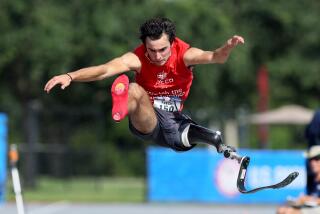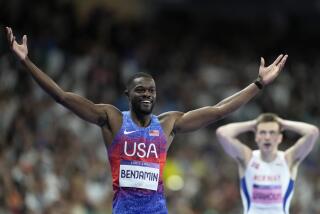One More Fling
- Share via
In most sports it’s so simple. The top individual finishers in the Olympic trials make the U.S. team.
Not so in the javelin. American throwers have performed so poorly in recent years that the winner of last month’s trials might not get a chance to compete in Sydney. And even if he goes, the second-place finisher, a five-time U.S. champion and American record holder, might be left behind.
Then there’s third-place finisher Todd Riech, 29, of Huntington Beach. He leaves for Europe this morning in search of a qualifying mark that he hopes will take him to Sydney for his second consecutive Olympics.
The fate of all three rests on whether one more U.S. thrower can reach the Olympic qualifying standard that was increased last year to 82 meters--269 feet. It’s a mark that only one U.S. thrower, the trials’ second-place finisher, Tom Pukstys, has reached since January 1999, the start of the qualifying period.
Breaux Greer, who won the U.S. trials last month, must either meet the qualifying standard or hope no one else does if he is to make the team.
Pukstys, who had the top 10 throws in the nation last year, needs a U.S. thrower other than himself to reach the 269-foot mark.
Riech, who has bettered that distance only once in his career and threw 252 feet in the trials this year, controls his fate and will begin what could be a six-week qualifying odyssey at a track and field meet Monday in Malmo, Sweden.
“I’m going to go until I get it, then come home,” Riech said, who was the only Native American competitor at the 1996 Games. “Hopefully, I’ll get it in the first meet.”
The IAAF allows athletes until Sept. 11 to achieve the Olympic standard, giving Riech a handful of remaining opportunities.
Riech last surpassed 82 meters shortly before winning the 1996 trials, joining Pukstys as the only American in last month’s field to throw that far. But the current qualifying standard has eliminated all but a few U.S. men’s throwers, who have finished in the top eight in the javelin only once since the 1952 Games.
Riech doesn’t feel like the sport has passed him by, even though some have already counted him out.
“This is all that’s been in the paper . . . ‘There’s only one qualifier in the javelin and so and so are non-qualifiers,’ ” Riech said. “Well, I don’t feel like a nonqualifier. I won’t feel like a nonqualifier until Sept. 11.”
The IAAF permits up to four athletes from each nation to be entered in an Olympic event, though only three can actually participate. It’s up to each nation’s governing body to determine who competes in case too many meet the qualifying standards.
Trials are one way to decide. If more than four competitors have met the standard, the top four finishers at the trials would go. But when Greer threw six feet farther than Pukstys, the U.S. qualifying process became more complicated.
“It’s a tough situation because I brought it on myself,” said Pukstys, who was slowed by a shoulder injury at the trials. “I have faith in those guys, especially Todd. If he can break out in the next week or two, I think he has a good chance to go.”
If Greer, Riech or another trials’ competitor fails to reach 82 meters before Sept. 11, only Greer will go to Sydney. That scenario would not only disappoint Riech and Pukstys, but the USATF as well.
“We want to send as many athletes to Sydney as possible,” explained Jill Geer, a spokesperson for the USATF. “It doesn’t matter if it’s the top three [from the trials] or first, second and 10th.”
Elbow surgery sidelined Riech for much of 1997 and ‘98, and he only competed in a few events last year. But Riech remains confident he can return to his form of four years ago. All he asks for is a slight tail wind, some moist evening air and a runway long enough to accommodate his 105-foot approach.
At least he has the emotional support he needs from his wife.
Lisa Riech, who graduated from Marina High as Lisa Coleman in 1987, also competed at the Olympic trials. Her event is the high jump, but she didn’t clear the opening height of 5-10 3/4, a height she has made at dozens of meets.
“Because my event was first, I gave myself a day to wallow in my sorrow,” Lisa said. “But then the next day I said, ‘I better be there for him because I don’t want to bring him down with me.’ ”
Although the trials did not go as well as either of them hoped, the week provided some bonding time for a marriage barely five months old.
“Lisa and I are so new in our marriage and when you see that side of your better half, you’re like, ‘Wow, it’s great to have somebody like that,’ ” Todd said. “I guess that’s how your relationship grows. She sees you going through it, she knows how much I want it and she knows how much it means to me.”
Riech grew up on the sprawling Flathead-Kootenai Indian reservation in Montana, dominating his peers on playing surfaces from Billings to Butte.
Part Native American and part German, Riech was a finalist in the 100 meters at the AAU national championships when he was 10. He also averaged 33 points a game in basketball as a high school senior, the same year he won five individual events at the state track and field championships.
He accepted a track and field scholarship to Fresno State, where he was a four-time All-American and NCAA champion in the javelin as a senior.
Riech’s career reached a pinnacle when he threw 81.86 meters (268.86 feet) to upset Pukstys at the 1996 Olympic trials and earn a spot on the U.S. team.
“It was great,” said Riech, who went on to finish 17th in Atlanta. “You dream about it all your life. I knew that it was my time. For some reason, I just knew I was going to win that thing.”
With his participation in the 1996 Games, Riech joined the legendary Jim Thorpe as one of the few American Indians to compete in the Olympics.
“There aren’t very many Native Americans who get off the reservation to go do anything [in sports],” Riech said. “It was strange for me to see that because there were a lot of great athletes. I always wanted to be the one that went and actually did something and brought it back.”
Riech was hoping to get something back from his community as well.
The Native American Sports Council contributed $10,000 to Riech in 1996 for living and training expenses, and his tribe raised $2,000 for expenses related to his Olympic training this year.
But Riech was disappointed when a nationally circulated Indian newspaper received only $207 after soliciting donations.
“That was upsetting for me because a lot of Native Americans around the country wondered, ‘Why aren’t more Native Americans in the Olympic Games?’ ” said Riech, who estimates that it costs $40,000 for the year to 18 months of training it takes to prepare for the Games.
“And that’s why, because nobody wants to stand by [Native American Olympians]. I thank the people who did donate, but I was astonished that only $207 came in.”
Riech said he pays for most of his training expenses. One of his sponsors markets training supplements and provides them free to Riech, who estimates that saves him about $250 a month.
He isn’t sure what direction his life will take after his Olympic chase ends. Riech is already considering trying again four years from now, but may instead decide to open a personal training business in Orange County.
He said he may even take Lisa and return to his roots.
“It’s quite expensive down here,” Riech said. “Nothing like the Montana prices.”
More to Read
Go beyond the scoreboard
Get the latest on L.A.'s teams in the daily Sports Report newsletter.
You may occasionally receive promotional content from the Los Angeles Times.






